

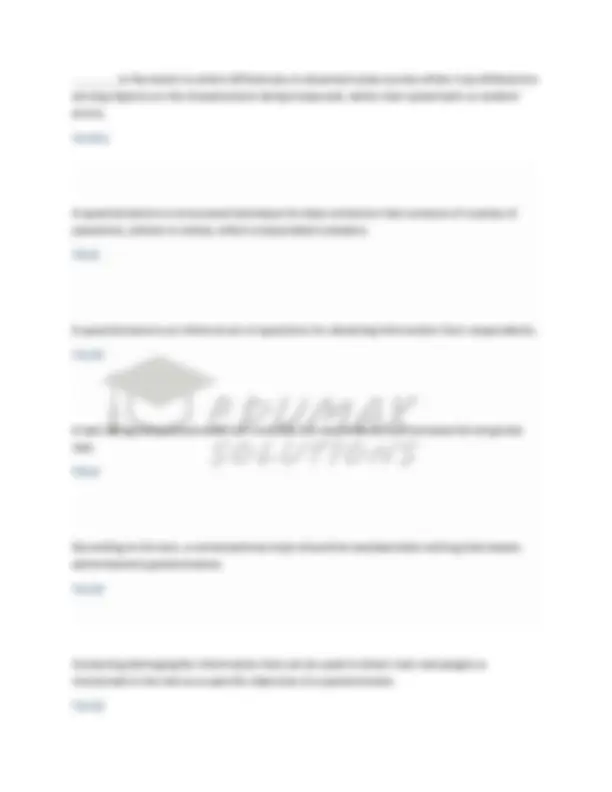



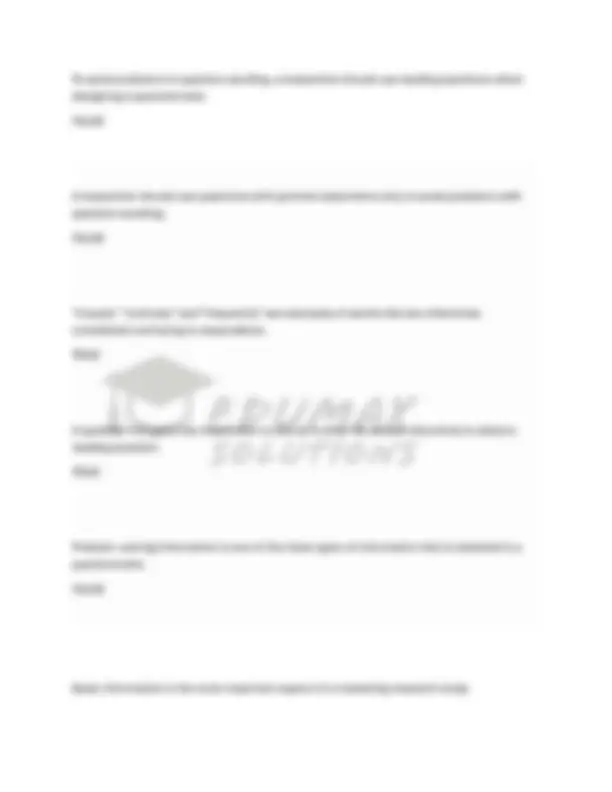

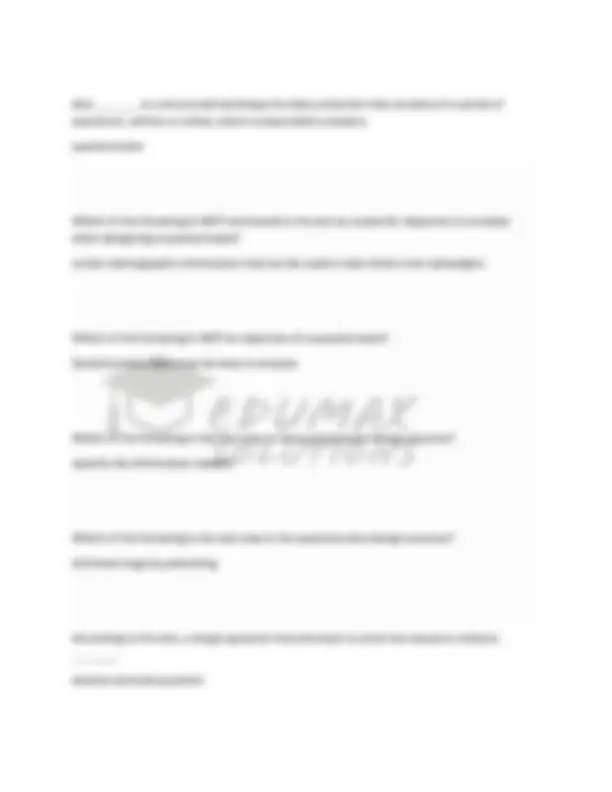


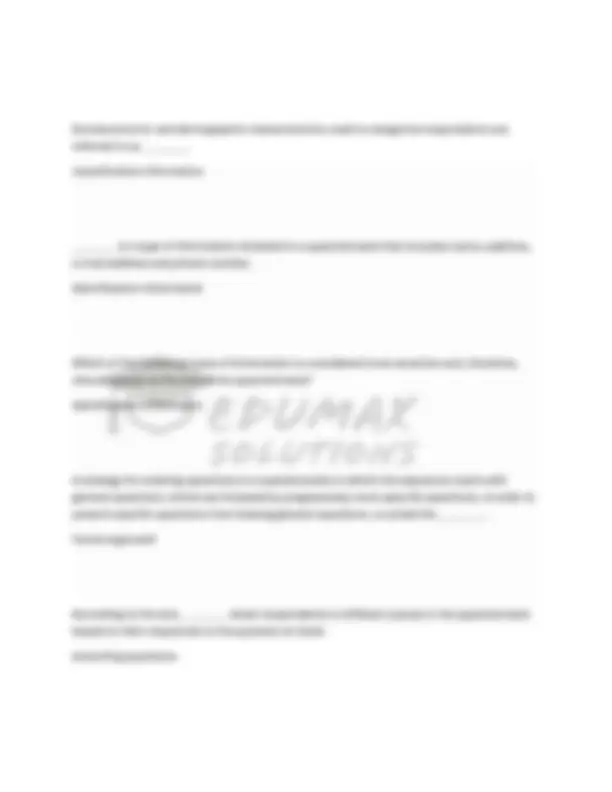
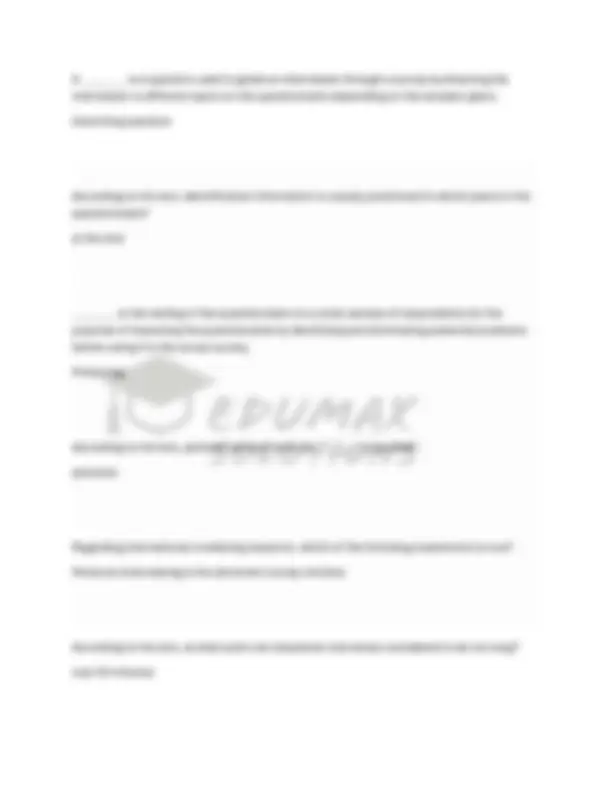
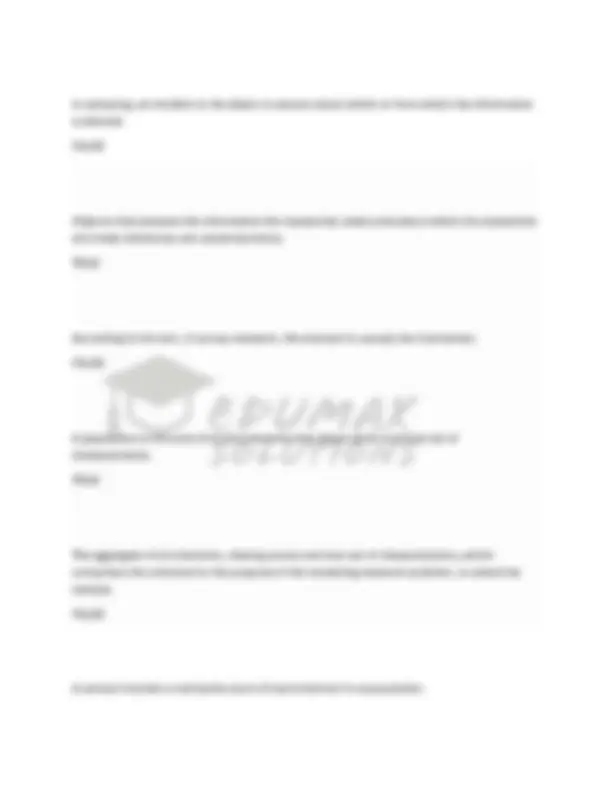
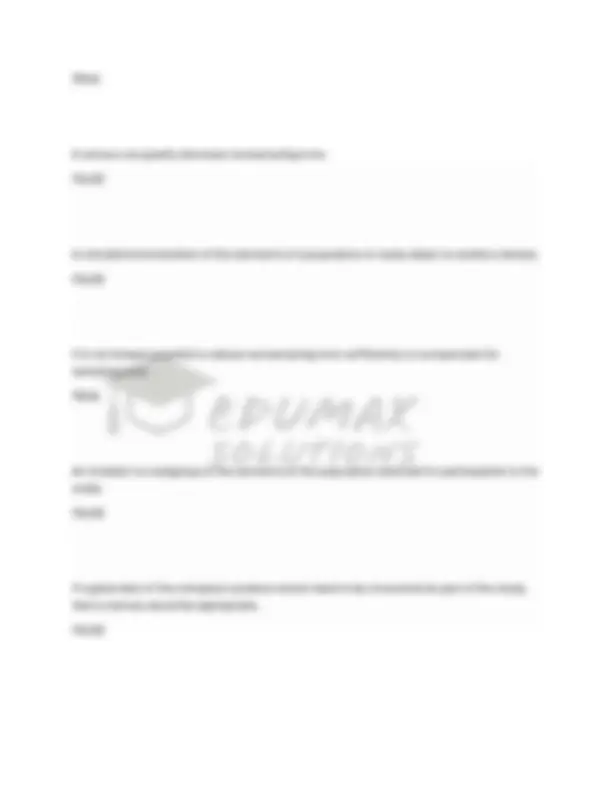
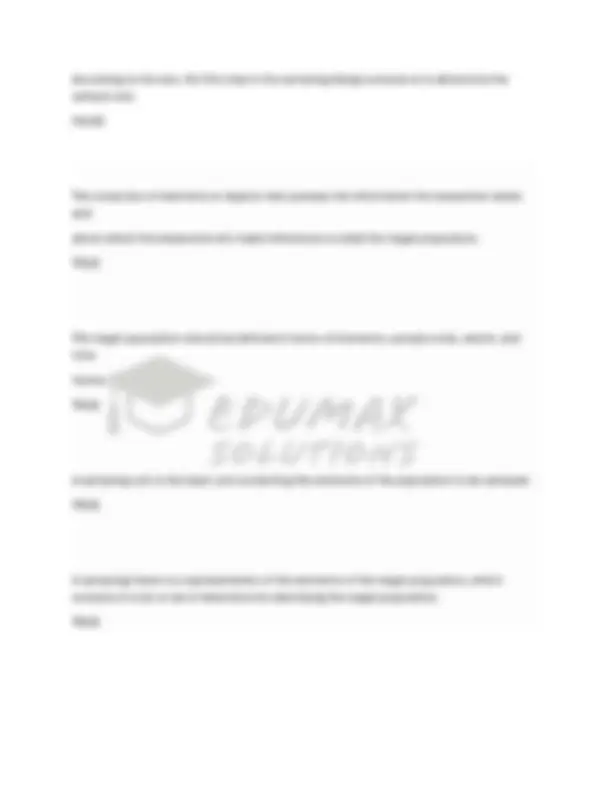
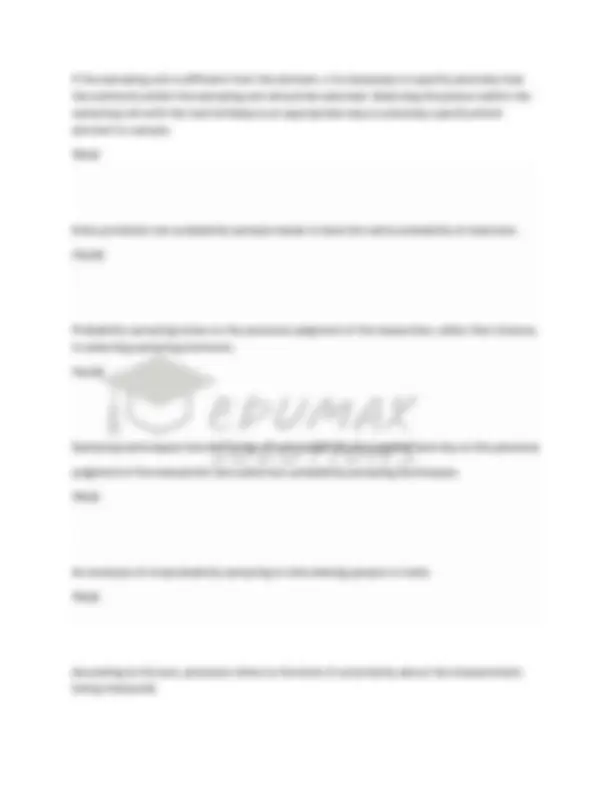


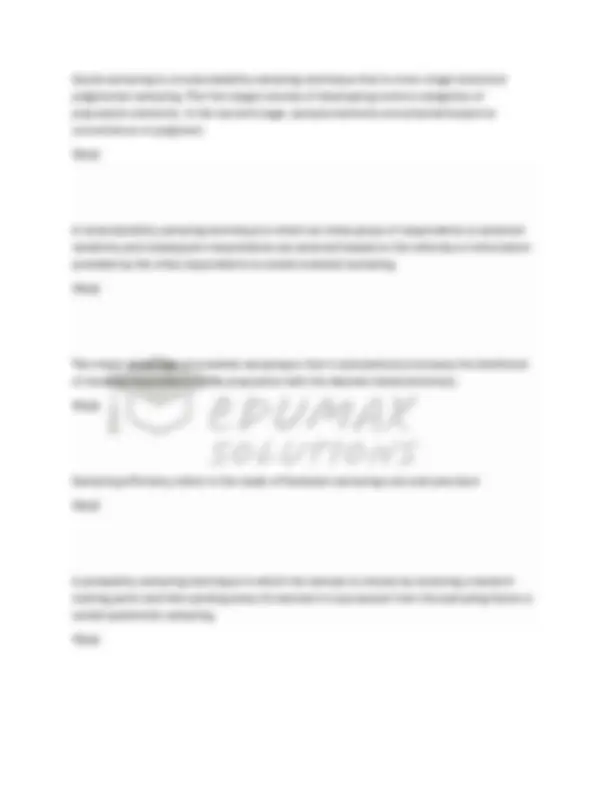







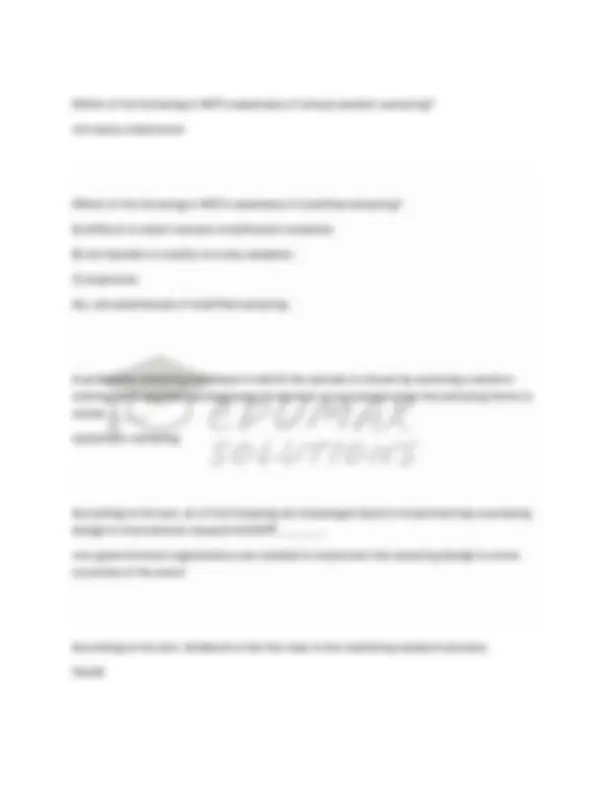





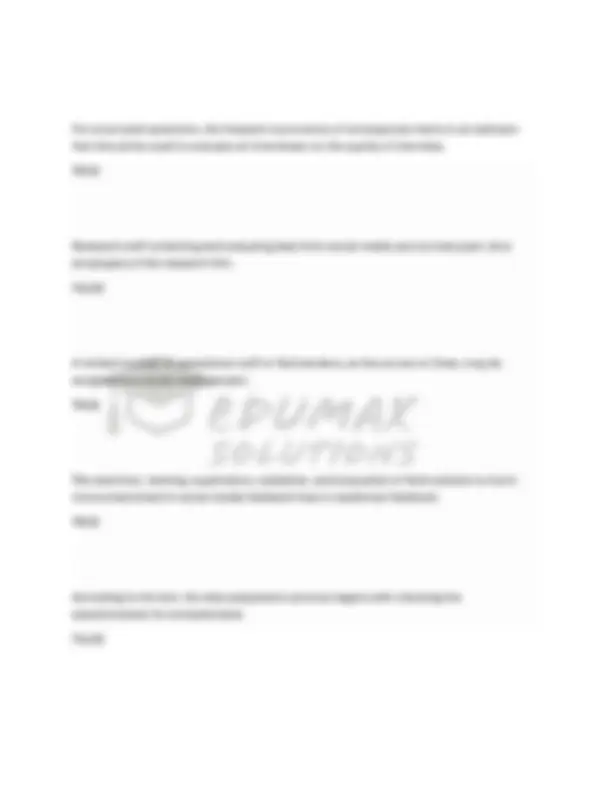
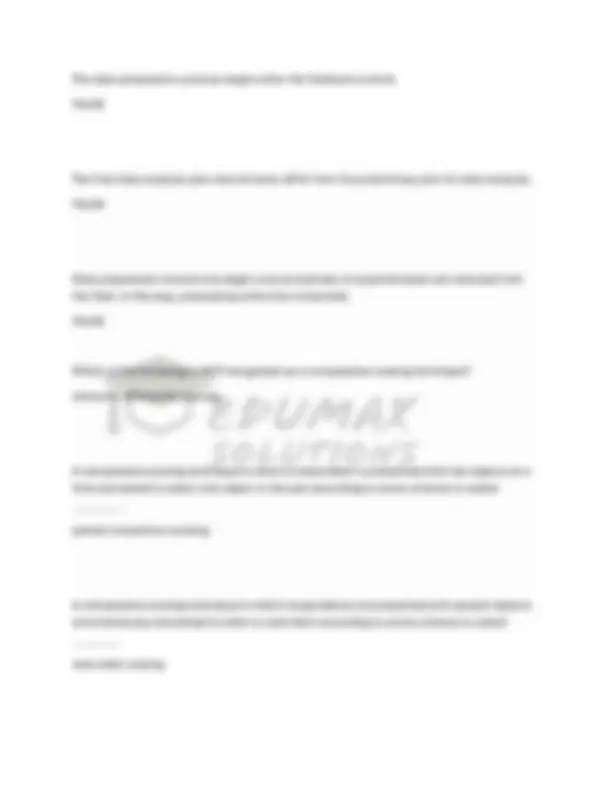
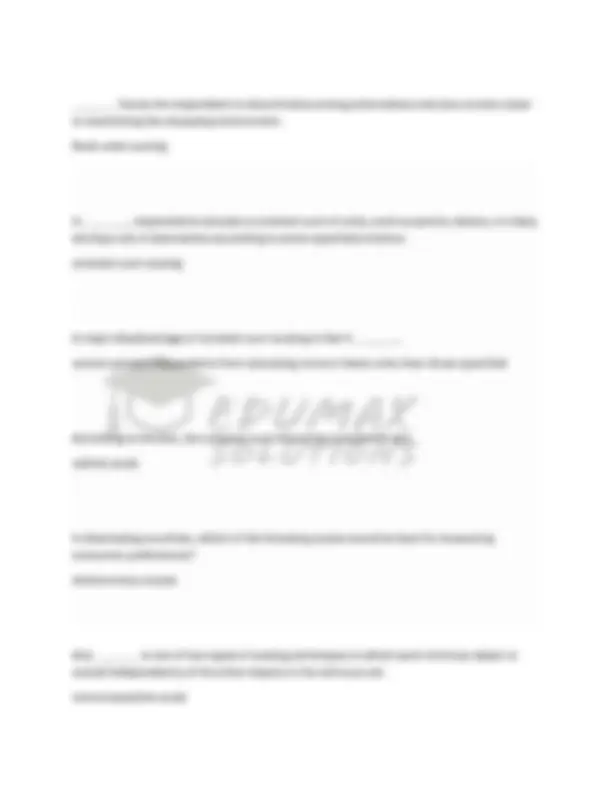








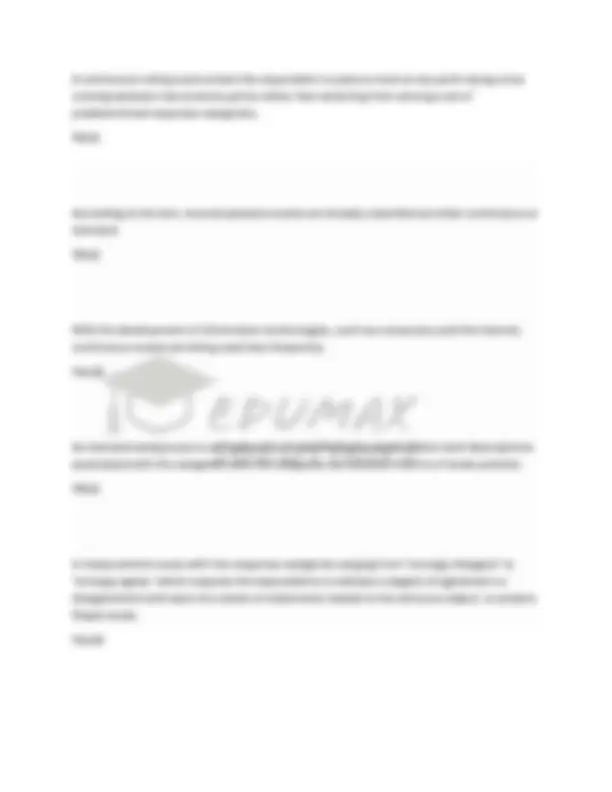


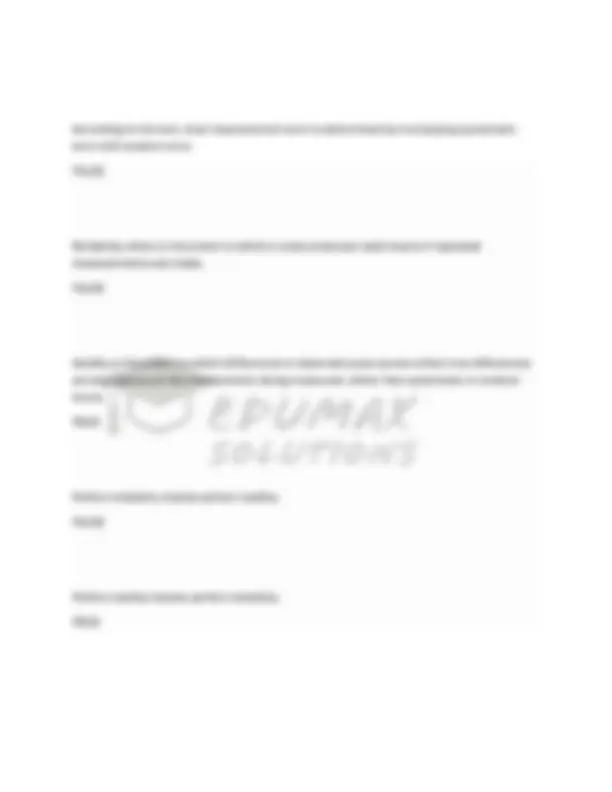




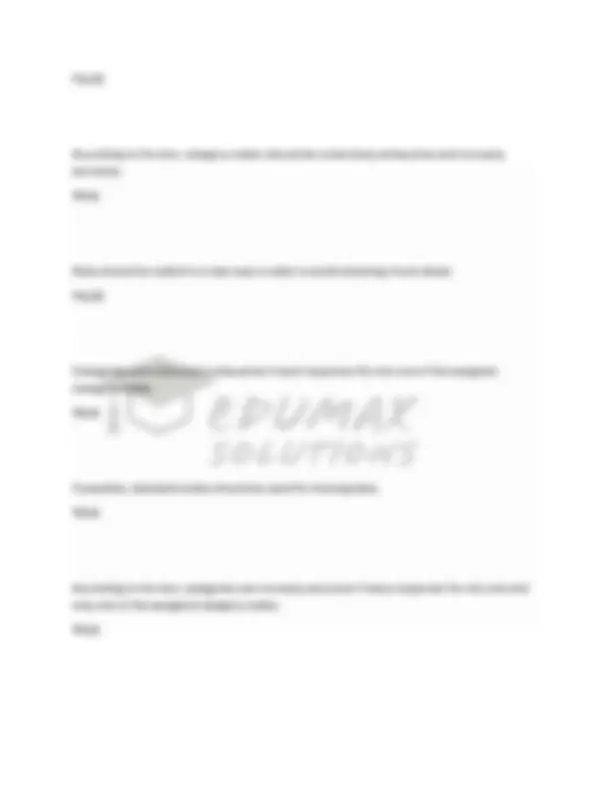

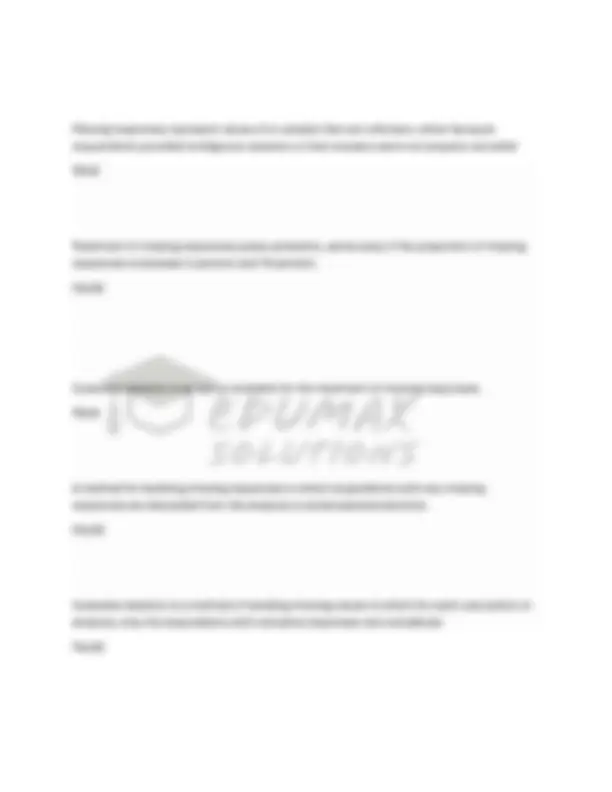
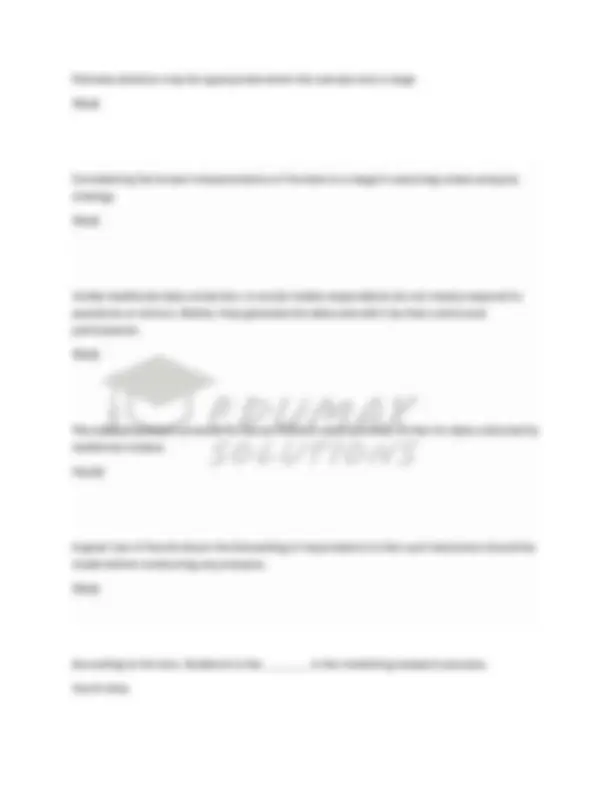
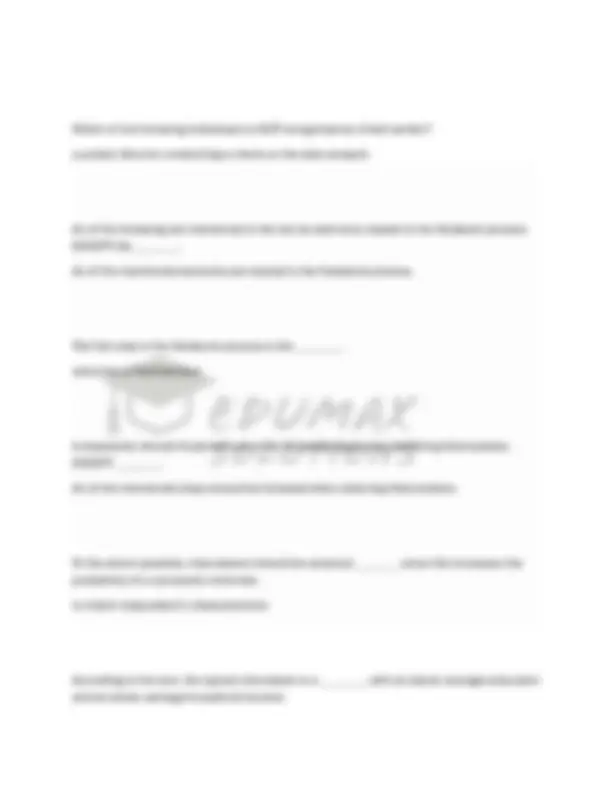







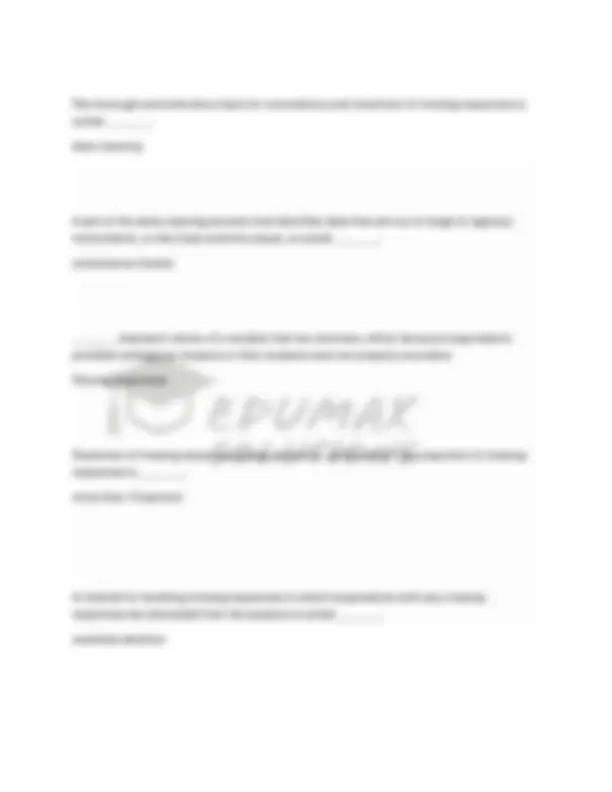



Study with the several resources on Docsity

Earn points by helping other students or get them with a premium plan


Prepare for your exams
Study with the several resources on Docsity

Earn points to download
Earn points by helping other students or get them with a premium plan
Community
Ask the community for help and clear up your study doubts
Discover the best universities in your country according to Docsity users
Free resources
Download our free guides on studying techniques, anxiety management strategies, and thesis advice from Docsity tutors
MKT 3413 WU FULL ACTUAL EXAM 3 CURRENTLY TESTING 400+ QUESTIONS WITH COMPLETE SOLUTIONS
Typology: Exams
1 / 73

This page cannot be seen from the preview
Don't miss anything!


































































A(n) ________ is a measurement scale having numbers and/or brief descriptions associated with each category with the categories ordered in terms of scale position. itemized rating scale A measurement scale with five response categories ranging from "strongly disagree" to "strongly agree" which requires the respondents to indicate a degree of agreement or disagreement with each of a series of statements related to the stimulus object is called a(n) ________. Likert scale Which of the following is NOT a characteristic of the Likert scale? respondents read a short phrase rather than an entire statement Which of the following types of scales is described as a seven-point rating scale with end points associated with bipolar labels that have semantic meaning? semantic differential When using a(n) ________, the respondent is typically asked to rate a brand, store, or some other object in terms of bipolar adjectives, such as cold and warm. semantic differential
A scale for measuring attitudes that consists of a single adjective in the middle of an even- numbered range of values is called a ________. Stapel scale Which noncomparative scale is analyzed using profile analysis? A) Likert scale B) semantic differential scale C) Stapel scale ALL OF THE ABOVE What type of scale is this? Sears is: Powerful —:—:—:—:-X-:—:—: Weak Unreliable —:—:—:—:—:-X-:—: Reliable semantic differential scale Scale categories can be ________. A) assigned numerical values B) presented horizontally C) expressed by boxes D) expressed by discrete lines ALL OF THE ABOVE
________ is the extent to which differences in observed scale scores reflect true differences among objects on the characteristic being measured, rather than systematic or random errors. Validity A questionnaire is a structured technique for data collection that consists of a series of questions, written or verbal, which a respondent answers. TRUE A questionnaire is an informal set of questions for obtaining information from respondents. FALSE A well-designed questionnaire can motivate the respondents and increase the response rate. TRUE According to the text, a conversational style should be avoided when writing interviewer- administered questionnaires. FALSE Collecting demographic information that can be used in direct mail campaigns is mentioned in the text as a specific objective of a questionnaire. FALSE
The last step in the questionnaire design process is to reproduce the questionnaire. FALSE A single question that attempts to cover two issues is called a double-barreled question. TRUE When respondents are unable to articulate a response to a question, this usually indicates they have no opinion on that topic. FALSE To increase the likelihood of obtaining sensitive information, such topics should be placed in the middle of the questionnaire. FALSE Which of the following primary scales of measurement is used for classification purposes? nominal scales In a department store project, numbers 1 through 10 were assigned to the 10 stores considered in the study. Suppose store number 9 referred to Sears and store number 6 referred to Neiman Marcus. Using this information, which of the following statements is true?
A(n) ________ is a scale in which the numbers are used to rate objects such that numerically equal distances on the scale represent equal distances in the characteristic being measured. interval scale A(n) ________ is the highest level of measurement and allows the researcher to identify or classify objects, rank the objects, and compare intervals or differences. ratio scale The scaling techniques commonly used in marketing research can be classified into ________ and ________. comparative; noncomparative scales A ________ is one of the two types of scaling techniques in which there is direct comparison of stimulus objects with one another. comparative scale A major disadvantage of comparative scales would be which of the following? A researcher cannot generalize beyond the objects under study. According to the text, comparative scaling is sometimes referred to as ________. nonmetric scaling
A(n) ________ is one of two types of scaling techniques in which each stimulus object is scaled independently of the others. noncomparative scale Which of the following is NOT a classification of itemized rating scales? perceptual scales Open-ended is a popular form of structured question. FALSE Open-ended questions that respondents answer in their own words are called unstructured questions. TRUE According to the text, unstructured questions are also referred to as free-response or free- answer questions. TRUE Dichotomous questions allow the respondent to express their attitudes or opinions without the bias associated with restricting responses to predefined alternatives. FALSE
To avoid problems in question wording, a researcher should use leading questions when designing a questionnaire. FALSE A researcher should use questions with positive statements only to avoid problems with question-wording. FALSE "Usually" "normally" and "frequently" are examples of words that are oftentimes considered confusing to respondents. TRUE A question that gives the respondent a clue as to what the answer should be is called a leading question. TRUE Problem-solving information is one of the three types of information that is obtained in a questionnaire. FALSE Basic information is the most important aspect of a marketing research study.
According to the text, classification information is information that relates directly to the marketing research problem. FALSE Socioeconomic and demographic characteristics used to categorize respondents are referred to as basic information. FALSE Identification information is a type of information obtained in a questionnaire that includes name, address, and phone number. TRUE Classification information is considered most sensitive and, therefore, should appear at the very end of the questionnaire. FALSE A strategy for ordering questions in a questionnaire in which the sequence starts with the general questions, which are followed by progressively more specific questions, in order to prevent specific questions from biasing general questions, is called the funnel approach. TRUE
One consistency in conducting cross-national studies is the universal definition of "household" and "household size" across countries of the world. FALSE Forms for recording observational data are more difficult to construct than questionnaires. FALSE Analysis of social media can give an understanding that can be valuable in designing an appropriate questionnaire for use in social media surveys but not in traditional surveys. FALSE An analysis of social media content can aid in determining the content, structure, and wording of individual questions. TRUE For questionnaires to be used in surveys to be conducted in social media, the general principles and guidelines for questionnaire design remain the same as those for traditional media. TRUE
A(n) ________ is a structured technique for data collection that consists of a series of questions, written or verbal, which a respondent answers. questionnaire Which of the following is NOT mentioned in the text as a specific objective to consider when designing a questionnaire? collect demographic information that can be used in later direct mail campaigns Which of the following is NOT an objective of a questionnaire? Questionnaire data must be easy to analyze. Which of the following is the first step in the questionnaire design process? specify the information needed Which of the following is the last step in the questionnaire design process? eliminate bugs by pretesting According to the text, a single question that attempts to cover two issues is called a ________. double-barreled question
Open-ended questions that respondents answer in their own words are called ________. unstructured questions According to the text, ________ are also referred to as free-response or free-answer questions. unstructured questions Which of the following types of questions allow respondents to express their attitudes or opinions without the bias associated with restricting responses to predefined alternatives? open-ended questions All of the following are mentioned in the text as disadvantages that are related to unstructured questions EXCEPT ________. respondent response limitations Open-ended questions are most useful in ________ and as opening questions. exploratory research Questions that pre-specify the set of response alternatives and the response format are called ________. structured questions
In ________, the researcher provides a choice of answers, and respondents are asked to select one or more of the alternatives given. multiple-choice questions A(n) ________ is a structured question with only two response alternatives, such as yes or no. dichotomous question According to the text, ________ should be used when the researcher has reason to believe that the respondent thinks of the topic in yes/no terms. dichotomous questions In wording questions, the researcher should avoid doing all of the following EXCEPT ________. use positive and negative statements Which of the following of the 6 W's is NOT particularly well-suited for serving as a guideline for defining the issue in a question? Why
Socioeconomic and demographic characteristics used to categorize respondents are referred to as ________. classification information ________ is a type of information obtained in a questionnaire that includes name, address, e-mail address and phone number. Identification information Which of the following types of information is considered most sensitive and, therefore, should appear at the end of the questionnaire? identification information A strategy for ordering questions in a questionnaire in which the sequence starts with general questions, which are followed by progressively more specific questions, in order to prevent specific questions from biasing general questions, is called the ________. funnel approach According to the text, ________ direct respondents to different places in the questionnaire based on their responses to the question at hand. branching questions
A ________ is a question used to guide an interviewer through a survey by directing the interviewer to different spots on the questionnaire depending on the answers given. branching question According to the text, identification information is usually positioned in which place in the questionnaire? at the end ________ is the testing of the questionnaire on a small sample of respondents for the purpose of improving the questionnaire by identifying and eliminating potential problems before using it in the actual survey. Pretesting According to the text, pretests are best done by ________ interviews. personal Regarding international marketing research, which of the following statements is true? Personal interviewing is the dominant survey method. According to the text, at what point are telephone interviews considered to be too long? over 30 minutes